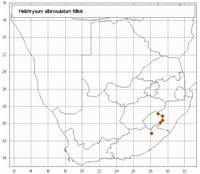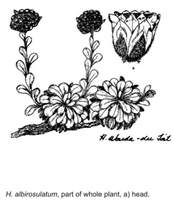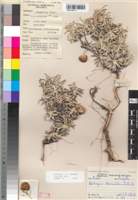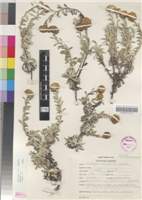Origin of name:
albirosulatum = white rosette
Diagnostic characters:
Compact short-stalked flower headsBrown bractsMany leaf rosettes on short stalks
Description:
Prostrate well-branched shrublet, main branches bare, up to 10 mm diam., with numerous erect leafy dwarf lateral branches, flowering branches up to 120 mm long, often decumbent then erect, silvery-white felted, closely leafy throughout. Leaves at first rosetted at the branch tips, up to 25 x 6 mm, spathulate, apex rounded or subacute, slightly recurved, base half-clasping, both surfaces enveloped in silvery white, slightly glossy, very closely felted indumentum, stem leaves similar but often smaller and narrower. Heads homogamous, subcylindric, c. 4 x 2�3 mm, many felted together at the base in a congested, rounded, corymbose cluster 10�20 mm across. Involucral bracts in c. 3 series, loosely imbricate, about equaling flowers, obtuse, not radiating, translucent, pale yellow washed golden-brown outside. Receptacle shortly honeycombed. Flowers c. 8�26, yellow. Achenes 1 mm, with myxogenic duplex hairs. Pappus bristles c. 6�10, tips plumose, shaft nude, bases not cohering.
Flowers between January and March.
Distribution:
Appears to be confined to Cave Sandstone, sprawling over platforms of this rock. Recorded along the Drakensberg from Cathedral Peak (Bergville district) to Underberg district, in Sehlabathebe Nature Reserve in Lesotho, with one collection from Bazeia Mountain near Engcobo in the Eastern Cape.
Grassland Biome.
Taxonomy:
Literature:
Helichrysum albirosulatum Killick in Bothalia 7: 23 (1958); Hilliard, Compositae in Natal 162 (1977).
Type:
KwaZulu-Natal, Bergville distr., Cathedral Peak Forest Research Station, Killick 1919 (PRE, holo.; K, iso.).
Synonym(s):
Vouchers:
Hilliard & Burtt 9719 (E; NU); Hoener 2186 (E; NU; PRE); Wright 455 (E; K; M; NH; NU).



